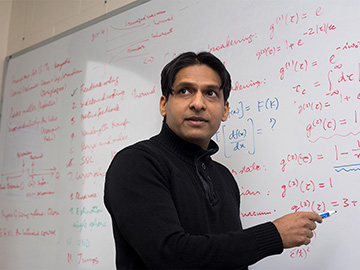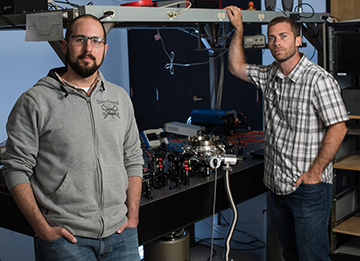![]()
Researchers from Rochester Institute of Technology and the University of Rochester, USA, have proposed and demonstrated a phonon laser using an optically levitated nanoparticle. [Image: A. Nick Vamivakas and Michael Osadciw, University of Rochester illustration]
The enormously fruitful technology of optical tweezers, which garnered a share of the 2018 Nobel prize in physics for pioneer (and OSA Honorary Member) Arthur Ashkin, has allowed the trapping and manipulation of nanoparticles, microbes and other minuscule objects in fields of laser light (see “Then and Now,” OPN, December 2018). Now, U.S. scientists have chalked up another win for the technology: the creation of a new type of “laser for sound” (Nat. Photon., doi: 10.1038/s41566-019-0395-5).
In the work, led by OSA Fellow Nick Vamivakas of the University of Rochester (UoR) and OSA member Mishkat Bhattacharya of the Rochester Institute of Technology (RIT), researchers used clever feedback loops to optomechanically manipulate the oscillations of a silica nanosphere levitated in an optical trap. In so doing, they were able to create laser-like amplification and coherence of phonons—quanta of vibrational or acoustic energy, analogous to photons in the optical domain.
The UoR–RIT team believes that the setup—while not the first phonon laser—opens up a general technique for creating frequency-tunable sound lasers in a system-size range that hasn’t previously been explored. The result, according to the researchers, could provide a useful tool both in metrology and sensing, and in more theoretical study of quantum states and quantum information.
Targeting “mesoscopic” systems
Phonon lasers—devices that rely on vibrational amplification by stimulated emission of radiation, analogous to light amplification in an optical laser—have existed both conceptually and experimentally since the late 1990s. But these phonon lasers have tended to leverage systems at the atomic and ionic scale, with masses on the order of 10–22 g, or “microscale” systems with masses in the microgram area.
In contrast, laser-like coherence of phonons had not yet been demonstrated for levitated “mesoscopic” optomechanical systems, involving subwavelength particles in the femtogram (10–15 g) range. That’s an important gap, as such levitated optomechanical systems have rapidly developed in recent years, and offer a key platform for tests of fundamental quantum mechanics and gravity (see “Levitated Optomechanics,” OPN, July/August 2016).
Getting the right equation

OSA member Mishkat Bhattacharya led the RIT team that developed the theoretical model and governing equation for the phonon laser. [Image: A. Sue Weisler/ Rochester Institute of Technology]
To close that experimental gap, the researchers began at the whiteboard. Building on a previously developed quantum model of cooling and force sensing for an optically trapped nanoparticle (Optica, doi: 10.1364/OPTICA.3.000318), Bhattacharya’s theoretical team at RIT rolled the system dynamics, diffusive and dissipative interactions, and feedbacks into a master governing equation.
The equation included a linear phonon amplification or heating term, analogous to optical laser gain, and a nonlinear damping or cooling term, promoting oscillator stability. In principle, by measuring the motion of an optically levitated nanoparticle in real time, and using dynamic feedback loops to adjust these linear-amplification and nonlinear-cooling terms in the right way, researchers could coherently amplify the phonons attributable to the particle’s vibration.
In so doing, as co-team-leader Vamivakas noted in a press release accompanying the work’s publication, the researchers could create “mechanical motion that is analogous to what you would see if you turned on an ordinary optical laser in our labs.”
Elegant experiment
To test out the scheme, Vamivakas’ experimental team at UoR set up an elegant experiment. The setup begins with an optical-tweezer apparatus consisting of a 1064-nm laser, focused through a microscope objective within a vacuum chamber, and hooked up to an electro-optic modulator (EOM) to provide feedback control on the beam power. The tweezer setup was used to trap and levitate a silica nanosphere on the order of 150 nm in diameter.

OSA Fellow A. Nick Vamivakas (right) and coauthor Levi Neukirch (now a researcher at Los Alamos National Laboratory) in a UoR lab. [Image: J. Adam Fenster/University of Rochester]
As the nanoparticle vibrates (initially owing to random or Brownian motion) within the trap, a photodetector captures scattered light from the particle, which is analyzed by three balanced photodiodes to determine the particle’s precise 3-D center-of-mass position. That position information is then passed into two electronic feedback loops—one controlling the linear-amplification term in Bhattacharya’s governing equation, and one controlling the nonlinear-cooling/stability term. The feedback loops cycle back to the EOM, adjusting the power of the optical trap and, thus, the position and mechanical oscillation of the nanoparticle. And the measurement–feedback cycle begins again.
Threshold behavior
By tweaking and adjusting these feedback loops, the team was able to demonstrate a clear transition from Brownian (random) motion of the levitated particle to laser-like coherent phonon oscillations. In addition to this “threshold” behavior, the team showed amplification of the phonon number, saturation behavior and even frequency tunability of the phonon oscillations, in a direct analog to an optical laser. “The mechanical vibrations become intense and fall into perfect sync,” Bhattacharya said in a press release, “just like the electromagnetic waves emerging from an optical laser.”
The investigators see potential applications for the device in sensing and metrology, as well as in quantum information—but they admit it’s early days and that much basic theoretical and experimental ground still needs to be covered. “It’s like when the laser was first discovered,” said Vamivakas. “Nobody knew what the laser would actually be used for. At this point, it is the demonstration that matters.”
